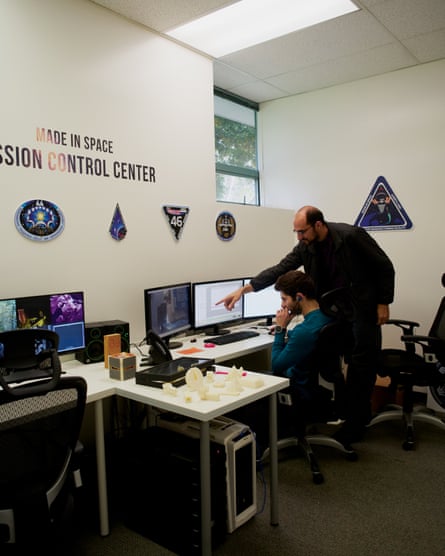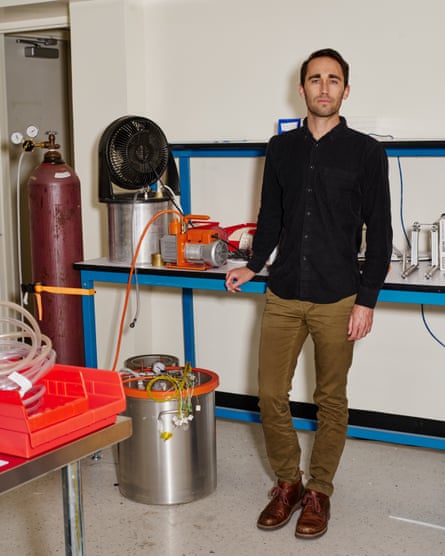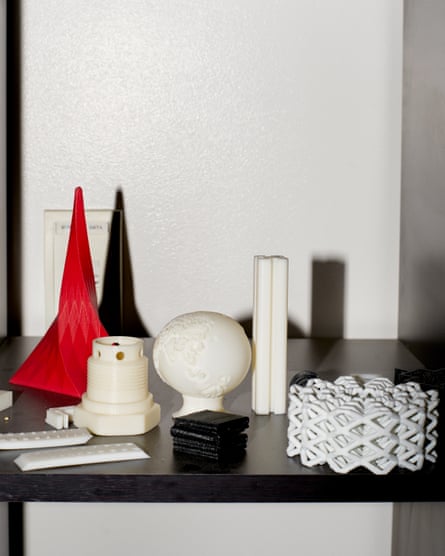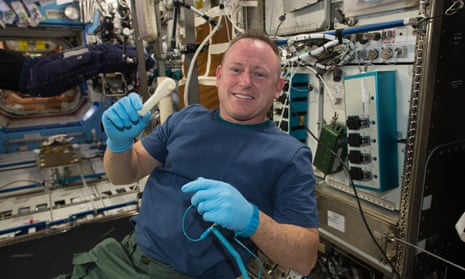During the early weeks of his 167-day stint aboard the International Space Station in 2014, astronaut Barry “Butch” Wilmore noticed that a torque wrench was missing. “It’s not uncommon for things to disappear in space,” he tells me over the phone from the Johnson Space Center in Houston. “You just don’t have gravity keeping stuff in place.” Wilmore mentioned the missing tool to Nasa’s mission control as he was tending to a 3D printer, a microwave-sized box that extrudes heated plastic to build up objects layer by layer, which was being tested on the space station.
About a week later, Wilmore opened the door to the 3D printer to find a perfect replica of his missing wrench. He was thrilled, a moment captured in a photo that was shared with the world’s media at the time. Until that point, the machine had produced only very simple objects. “This was a printed, all-inclusive wrench, with a ratchet mechanism, that worked,” Wilmore says.
Unbeknown to the astronaut, the team that designed and operated the 3D printer – a California-based company called Made In Space – had been listening in on his conversation with Nasa (a privilege for companies working with the space agency) and worked round the clock to design a version of the tool that met Nasa’s rigorous safety requirements.
“Once Nasa approved the wrench, we sent the file to the printer – essentially we emailed it to space and hit print,” says Jason Dunn, Made In Space’s co-founder and chief technology officer, sitting across the table in a conference room at the company’s headquarters in Moffett Field, Santa Clara County. “I get goosebumps every time I think about that story.”
For Dunn, that wrench is symbolic of an entirely new frontier in space exploration, one in which his eight-year-old company is a pioneer: manufacturing items in space, rather than relying only on those objects you can find room to pack on a rocket from Earth.
“It’s a really neat capability that allows us as humans to extend our reach beyond Earth,” he tells me. Supplying the 3D printer on the International Space Station was only the start: the company is developing systems for making and assembling not only small tools and trinkets, but giant structures such as satellites and, eventually, even space colonies – houses on the surface of the moon or Mars, or giant spaceships on which people could live and work.
Dunn, 33, is sitting in a scruffy conference room called The Bridge – a nod to the Star Trek command centre – on the second of two floors in a long building that once served as barracks for the US navy and now houses most of Made In Space’s 43 employees. It’s one of dozens of nondescript white buildings dotted around Moffett Field in Mountain View, which was closed as a military base in 1994 and turned over to Nasa for research purposes. The agency leases buildings to different advanced technology companies with whom it has research ties. From the outside, there’s no sign of the cosmic ambition bubbling up inside.
With his stubble and dark hair, swept to one side, Dunn looks like a dishevelled Clark Kent. He traces his interest in exploration back to his childhood in Florida. He lived by the Gulf of Mexico, where he and his friends would spend hours in a little boat exploring mangroves and islands.
“I grew up with this fascination with exploration,” he says. “This idea that I sit on the shore and I look out and I can’t even see the horizon, and I don’t know what’s beyond it.”
That feeling grew after he watched the space shuttle launch from the nearby Kennedy Space Center at Cape Canaveral, seeing what looked like “a little star” moving up into the sky. “I remember the fascination of seeing that one star and thinking ‘There’s people on it, disappearing into space’,” he says. “Everyone on the planet sits on the shoreline of space. It’s this big ocean we should be exploring,” he adds, with a tinge of wistful disappointment about the lack of progress.
For Dunn, working at Nasa seemed inevitable: he was inspired by his high school physics teacher, who had been a finalist in a group of teachers selected by Nasa. Later, he studied aerospace engineering at the University of Orlando, where he worked on the shuttle programme via an internship at Boeing, which was contracted by Nasa to build the spacecraft.
Dunn was enamoured of the vision for the space shuttle. Initially sold to the US Congress in the early 1970s as a reusable vehicle that would fly to space on a routine basis, it promised a much cheaper way of sending things there. This led scientists and engineers to think creatively about what they could build if they weren’t hamstrung by the prohibitive cost. “Once we have low-cost access into and back from space, then the industry changes and opens up,” Dunn explains.

But the space shuttle did not fulfil this promise. It cost around $450m (£315m) every time it launched, so it didn’t fly nearly as frequently as proposed. In 2010, Nasa announced it was retiring the programme, after 30 years. “I felt a little heartbroken and very confused,” Dunn says, “because the whole reason I was doing this was to work on the space shuttle.”
Feeling lost, he turned to a college-based club called Students for the Exploration and Development of Space, where he met entrepreneur Peter Diamandis, founder of the X Prize, a non-profit organisation that stages lucrative competitions to reward teams who develop breakthrough innovations. Dunn learned that he could create a startup in the space industry. This seemed “ludicrous” at the time: to his mind, the space industry was the preserve of nation states and giant companies such as Lockheed Martin and Boeing.
In the summer of 2010, Dunn moved to California to attend Singularity University, an educational programme and business incubator co-founded by Diamandis, which focuses on “exponential” technologies such as artificial intelligence and driverless cars. There, Dunn met two of his Made In Space co-founders – Mike Chen and Aaron Kemmer – and together they spent 10 weeks researching the space industry and ideas for a sustainable business; the fourth co-founder, chief engineer Michael Snyder, joined shortly after.
The private space companies that attract the most attention – Elon Musk’s SpaceX, Virgin Galactic or Jeff Bezos’s Blue Origin – prioritise fulfilling the original promise of the space shuttle: making access to space cheaper, by building reusable or larger rockets. Dunn, Chen and Kemmer asked a different question: “What if we didn’t need to launch anything at all?”
Asking that question meant they were no longer restricted to dimensions of space objects that could be packed inside a rocket and able to survive the shuddering forces of a launch from Earth.
“We could have structures in space so big, they could be the backbone of huge internet telecommunications antenna,” Dunn says. “Or a giant space station colony, or giant arrays of solar panels. Or we could send robots to the surface of the moon, or Mars, and use resources there to build habitats.”
Dunn predicts that, over the next 10 years, space will become an industrial zone filled with orbiting factories. “Like oil platforms on the ocean, but not polluting.” There are already several companies – including Axiom Space, with which Made In Space has formed a partnership, and Bigelow Aerospace – building commercial space stations that could house manufacturing equipment in orbit within a couple of years, Dunn notes. Eventually, he says, people will go to the factories in space to work in much the same way as oil riggers do. “Although most of the manufacturing will be automated, you need people to fix and maintain the robots. It might not be pretty, it might not be that safe, but they will make a good living and then come back home.” Others will pay to go on “cruise ships”, either to orbit Earth or “do a nice week-long trip around the moon”. Companies such as Blue Origin and SpaceX are making “huge strides in delivering humans into space safely”.

The relationship between orbiting factories and launch companies will be symbiotic. “They are really opening the frontier of space,” Dunn says. “We built our company on the promise of what they are creating; they are building their companies based on the hope that Made In Spaces will exist.” He is close-lipped about specific commercial relationships with the launch companies, but says that his company is “actively working” with some of them.
Over time, manufacturers will start to populate Earth’s orbit, starting at lower altitudes and working their way out in concentric circles until they reach the moon. Made In Space is even preparing for a lunar colony by developing “rego” bricks, made by combining a special polymer with simulated moon dust (regolith). The bricks, which look like samples of paving stones in various shades of grey, are heavy and feel plasticky. In theory, a brick-making autonomous vehicle could use the dust on the surface of the moon to construct housing ahead of astronauts’ arrival.
Before building colonies on the moon, Made In Space had first to develop a 3D printer that worked in microgravity and could be put on the International Space Station. The printer is the company’s “foundational technology”, according to chief executive Andrew Rush, 33, a former intellectual property lawyer who came on board in 2015. He says he was “doomed to like space from birth”, having also grown up in Florida with parents who raised him on a diet of Star Trek, science fiction writer Robert Heinlein and physics books. Rush is one of many self-described sci-fi nerds at Made In Space. During interviews for new recruits, he will ask: “Star Trek or Star Wars?”
“It’s mostly for fun,” he says. “It’s certainly a bit of a culture fit indicator.”

I ask if Made In Space is more Star Trek or Star Wars. He laughs, then hesitates, reluctant to alienate an entire tribe of potential recruits. “You will get me in trouble,” he says, before conceding, “I think I’d say we are more Star Trek.” The life-sized cardboard cutout of Spock in the reception area is a bit of a giveaway. As are the framed posters on the wall by the stairs for 1960s episodes of sci-fi television series such as The Tholian Web and Mirror Mirror. “In Star Trek, the technology and the philosophy are often more motivating than in Star Wars, which is more of an epic-driven narrative and universe,” Rush explains, adding that “space is a team sport”.
Dunn agrees: “We are creating the technology of Star Trek, building the replicator and transporter all in one with 3D printers.”
At first, the team assumed that Nasa already had a 3D printer on the space station, but discovered that, although the agency had experimented with the idea in the late 1990s, it decided that the printing technology was too immature and the space station too small at the time to risk it. However, once the space station expanded, Nasa designated the US segment a national laboratory, inviting companies, research institutions and government agencies to pitch microgravity research projects. Made In Space flew out to the Marshall Space Flight Center in Alabama, to pitch the commercial potential for 3D printing in space.
The problem with regular 3D printers is that they are designed to work in gravity. Without that constant downward force, you have to secure every belt, cog and pulley – a few millimetres of unintended movement wreaks havoc on the printing mechanism, leading to failed or wonky printing.
To ensure their 3D printer would work on the International Space Station, the Made In Space team spent many hours aboard a “vomit comet”, a converted passenger jet that follows a rollercoaster trajectory, offering about 20 seconds of weightlessness with every nosedive. The team took their device on 10 such flights, each lasting around two hours, during which they monitored how the 3D printer was performing. “The feeling of zero gravity is impossible to explain,” Dunn explains. “It’s an entirely new feeling. Outside of when you’re an infant, you don’t really have entirely new feelings.”
The team also had to automate almost every part of the experiment – the combination of strong anti-nausea pills and the novel sensation of floating meant human-made decisions were virtually impossible. Adjustments would be made to the printer after each flight, until they finally cracked it on the 10th mission.

The printer was installed on the International Space Station in November 2014. The first thing it printed was a part for the printer: a plastic electronics cover about the size of a playing card with raised wording that read “Made In Space”. A month later, it would print the missing torque wrench, which underlined the potential of the technology to astronaut Barry Wilmore. “It’s going to be a game-changer, or as we say in Tennessee, it’s a big dang deal,” Wilmore tells me, although he adds that he wasn’t allowed to use the wrench because it had to be sent back to Earth for assessment.
In 2015, the company was awarded the Space Frontier Foundation’s Vision To Reality award, which recognises outstanding achievement in space. (Previously, it was given to SpaceX for the launch of its reusable Falcon 1 rocket and to the Nasa Kepler Program for its low-cost mission to find planets outside of our solar system.)
Staff operate the game-changing printer from their own mission control, a small office space with two work stations, each of them with three screens – some showing live video feeds from around the space station, others directly looking at what’s being printed. Made In Space will talk to a Nasa payload communications manager (a “Paycom”) in Houston, who will relay messages or instructions to the astronauts. On rare occasions, if there’s a complicated technical issue with one of the machines, Made In Space will communicate directly with astronauts.
Unlike most startups, particularly in capital-intensive industries such as space, Made In Space has never taken any external investment. The core technologies of the business have been funded through development contracts from Nasa and the Defense Advanced Research Projects Agency (Darpa). Research groups and companies also pay Made In Space for time spent using its microgravity 3D printer. The money from this core work allows the company to explore more out-there projects, such as building on the moon.
Made In Space’s most ambitious experiment is Archinaut, a robot-operated factory that would be placed in Earth’s orbit to build large structures in space. If it pulls it off, it has the potential to radically transform the way satellites and space telescopes are built, repaired and enhanced. Without having to worry about fitting everything into a launch rocket, these orbiting structures can be much, much bigger. And bigger means better: better arrays of solar panels for powering missions into deep space; better space telescopes for exploring the galaxies beyond our solar system and better satellite-delivered internet services on Earth. “You could send a satellite the size of a small refrigerator into orbit, then a robot would start to build it out,” Rush explains. “You could manufacture a 10m- to 15m-long antenna, the kind you usually get on a big honking 2,000kg satellite.”
To make large structures, Made In Space needed a 3D printer that could print off as long an object as required. It managed it: there’s a 37m-long strut stretching the length of the hallway on the ground floor of its headquarters. “It’s larger than the solar wing on the ISS,” Rush says (in February, it was awarded a Guinness World Record for being the world’s longest 3D-printed nonassembled piece).
The company is also thinking about the importing business, developing “space-enabled materials” – materials that can be manufactured only in microgravity, but which are needed on Earth. The first material made in this way was ZBLAN, a type of optical fibre that is structurally of higher quality than anything that can be made on Earth. Optical fibres, the blood vessels of the internet, are made by heating glass rods to melting temperature and drawing them out until they are thinner than a human hair. When that’s done on Earth, the different densities of the materials mean they can crystallise with tiny defects. “When we remove gravity, we allow the glass to crystallise in a uniform manner,” Dunn says. “Now you get a perfect glass crystal which allows light to pass through it with much more efficiency.”
ZBLAN is in high demand from telecommunications companies desperate to deliver more bandwidth to their data-hungry customers. “Industries are buying exotic optical fibre at such a high cost,” Dunn says, “you can justify flying raw materials into space, making it and bringing it back, and still have a successful business.”
With that in mind, Made In Space has developed a pilot factory contained inside a metal box roughly the size of a mini-fridge, which can produce a few kilometres of fibre per mission. So far, it’s only been tested fully on the space station once, before it was brought back to Earth to assess the quality of the fibre and tweak the system. This month, the machine is being installed a second time, for further testing.
Similarly, Archinaut has been tested only on Earth, with smaller structures built in vacuum chambers that simulate space conditions. The company’s flashy videos of dextrous robotic arms assembling satellites in orbit remain a science fiction. “People were writing about travelling to the stars before [Robert] Goddard had made a liquid-fuelled rocket,” Rush says. “Our vision and imagination for what we can do in space has always far outstripped what we’ve been able to do.”
If the space industry develops according to Made In Space’s plan – and that’s a big if – the ultimate aim is to help build space colonies the size of cities. For Dunn, this is a necessity. “It’s not about leaving Earth, but expanding and saving it,” he says, pointing out that there are not enough resources on our planet to give every person an equal standard of living to that enjoyed in many western nations: having a laptop, mobile phone and car. “There’s a limit to how much energy production we can handle, how much CO2 we can keep putting into the atmosphere, how much food we can produce. The only way those limits disappear is when we think beyond the boundary of this finite volume of Earth.”
Objects printed by Made In Space’s zero-gravity 3D printer will be exhibited during the V&A’s upcoming exhibition The Future Starts Here, from 12 May; go to vam.ac.uk/thefuturestartshere for details.
Commenting on this piece? If you would like your comment to be considered for inclusion on Weekend magazine’s letters page in print, please email weekend@theguardian.com, including your name and address (not for publication).

Comments (…)
Sign in or create your Guardian account to join the discussion